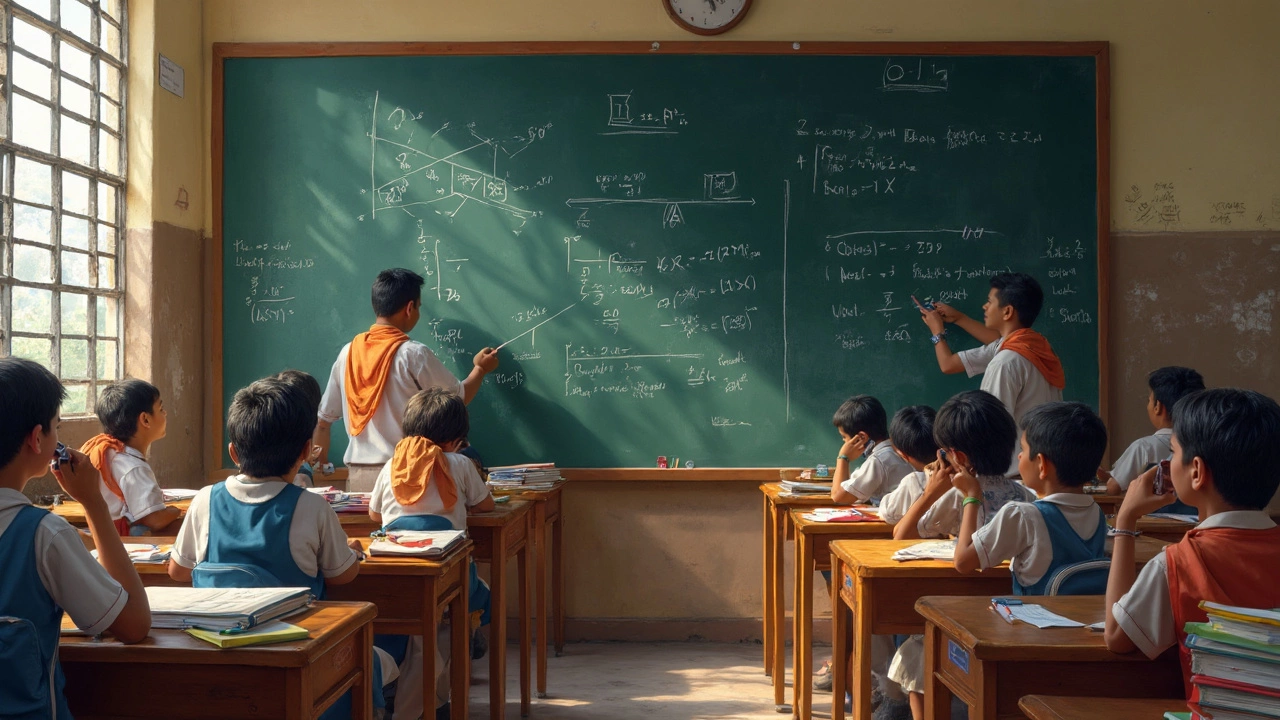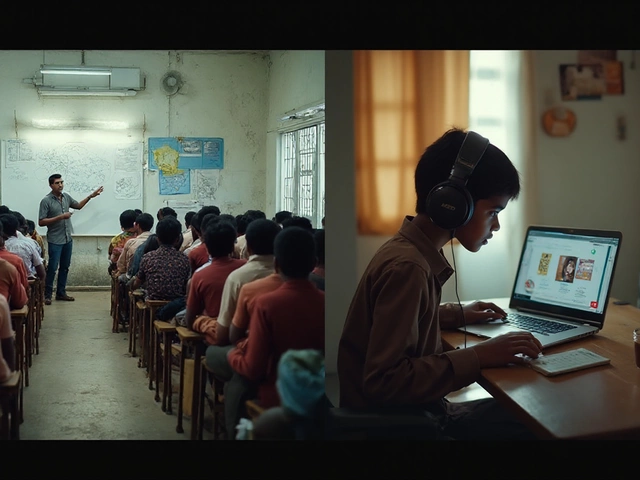
Picture a late-night kitchen table, some cold coffee, and a stressed-out teenager surrounded by a mountain of math work. Now, imagine multiplying that stress by ten. That's a slice of reality for kids in some countries tackling the world's toughest math challenges. The toughest math isn’t just about big numbers or weird symbols. It’s shaped by a mix of cultural pressure, teaching styles, and national pride. People always seem to think their country's math is the hardest (and the most important), but the truth is way more complicated—and honestly, a lot more interesting than you might think.
Math Anxiety Around the Globe: Why Some Countries Push So Hard
Let’s face it—math makes some people break out in a cold sweat, but in places like China, South Korea, Russia, and Singapore, there’s a kind of math fever. In these countries, math isn’t just one subject among many; it’s the core of academic success. Parents start prepping their kids for math competitions before most American kids can even multiply. Stories of 10-year-olds solving problems that would stump adults aren’t rare—they’re expected. It’s a status thing. Being good at math opens doors to the best schools and jobs, and in some countries, your whole future rides on a math test score.
Singapore tops nearly every global test, despite being a tiny island city-state. The country’s Primary School Leaving Examination in math is legendary. If you google “Singapore math problems,” you’ll find questions that have gone viral because adults around the world couldn’t solve them. Some ask about birthdays using tricky logic or expect 12-year-olds to know concepts that many Americans see in high school.
China and South Korea have their own story. The infamous “gaokao” exam in China is brutal—kids train like athletes for years, because only an amazing score lets them into top universities. A wrong answer can mean the difference between a comfortable life and one full of struggle. In South Korea, high schoolers face the College Scholastic Ability Test, which decides their university future in just one grueling day. Endless hours of “hagwon”—private cram school—leave kids with barely any free time. It’s no wonder some of the world’s most talented mathematicians come from these places.
Russia’s math teaching style is tough but creative. Famous for math olympiads, Russia encourages kids to play with ideas, not just memorize formulas. The math olympiad problems often appear bizarre—picture a question about painting the faces of a cube that quietly calls for university-level reasoning—and Russian students regularly take top medals at the International Mathematical Olympiad (IMO).
But does this pressure actually make people love math? Not always. Studies like PISA (Programme for International Student Assessment) show that kids in high-pressure math systems often feel more math anxiety, even while they outperform peers elsewhere. High scores, but high stress. Countries like Finland—where homework is light and school is more relaxed—sometimes have similar PISA results with much less pressure. The way each country approaches math says a lot about what they value: raw achievement, creativity, or maybe just survival.
Behind the Numbers: What Makes One Country’s Math Harder Than Another?
If you ask, “Which country has the hardest math?”—well, what do you mean by hard? Is it the amount of homework, the type of problems, or the competition to reach the top? In Singapore and East Asia, what stands out is depth. Kids learn fewer topics each year, but study them in intense detail. A 10-year-old might be proving geometry theorems or solving tricky word problems involving algebra. In the U.S., the curriculum is broader, but less deep—students jump from fractions to geometry to basic stats year after year, but don’t always master anything.
Russian math is a different beast. Kids who make it to special “math schools” dive into number theory, combinatorics, and geometry that would scare most adults. That’s part of why Russia and former Soviet countries punch above their weight at the International Math Olympiad. The math is creative, not just tough. Olympiad questions are legendary for being deceptively simple but mind-bendingly hard—like “Can you cover a chessboard with dominoes if two opposite corners are missing?” to see if a kid notices hidden patterns.
In Japan, high schoolers regularly encounter calculus and complex algebra. The infamous university entrance tests are designed to filter out everyone but the sharpest minds. There are stories of kids spending three years practicing just for the math section, with evening classes and endless problem sets. Japanese exams reward persistence and creative problem-solving over memorization.
But let’s talk about content: Singapore’s textbooks are direct, logical, and packed with visuals. They build math concepts brick by brick, but the problems get dangerously hard, quickly. Chinese math often demands speed and accuracy—think 50 problems in 60 minutes. Indian math textbooks, especially for the ICSE and CBSE boards, notoriously stuff proof-based geometry and number theory into early grades. Sometimes, the same math shows up in different countries, but the way it’s taught or tested makes all the difference.
That brings us to international competitions. The IMO isn’t just showboating—it’s a peak into which countries breed the most advanced problem solvers. In 2023, China and the U.S. tied for gold, while South Korea, Russia, and Singapore took top spots too. The problems involve advanced algebra, combinatorics, and geometry with twists that never show up in normal classes. The average high schooler would find them almost impossible. Yet, these kids train for years, sometimes attending “math camps” every summer to hone their skills.
So, “hardest” doesn’t have one answer. Some countries go wide but shallow, others dig deep into a handful of concepts, and some are obsessed with speed or creativity. But one thing is clear—being the best at math anywhere usually involves a cocktail of determination, discipline, and the ability to think differently under pressure.

What Kids Really Go Through: Behind Closed Doors of the World's Toughest Math Classes
Dive into a regular school day at a tough “math-specialized” school in Moscow. Kids, some only 12, are hunched over rough sheets of scrap paper, solving problems about modular arithmetic or constructing weird geometric shapes. The teacher starts the class with a story that has a math twist—maybe a tale about a bridge that collapsed because of a calculation error. Kids ask questions without raising their hands; the air is thick with ideas and tiny arguments about answers.
Now, zoom over to Shanghai. A “normal” math lesson could last 45 minutes, but the homework takes twice as long. Parents invest in private tutoring if their kid falls behind even a week. A test is waiting every Friday, and parents will compare scores with the neighbors by Saturday morning. If you’re not on top, you’re expected to “catch up”—not lower the bar. The legendary gaokao exam turns neighborhoods into hushed zones on test day, complete with police cordons to keep down the noise.
Singapore’s classroom vibe is different but equally intense. Teachers push for thorough understanding, not just rote learning. Kids draw bar models, break down problems step by step, and trade tips on tricky “challenge” questions. Peer competition is fierce, with term exams every few months. Top students may enter international contests, facing logic puzzles that stump professional engineers. Singapore trains math Olympiad hopefuls with weekend seminars and offbeat problem sets—part brain teaser, part logic boot camp.
In Japan, late nights solving past university entrance papers are common. Even average students spend hours mastering advanced concepts because the bar is so high for college. Many students join math clubs, not for fun, but for a competitive edge—even learning shortcuts for certain question types found only on Japanese tests.
Let’s not forget India—a country obsessed with math geniuses and famous exam pressure. Indian high schools offer “math streams” where students learn calculus, advanced trigonometry, and statistics before they’re 17. For many, cracking the Joint Entrance Examination (JEE) is the goal. The JEE math section includes logic, probability, and combinatorics—the kind of mental juggling that separates the truly talented from the merely good. Crash courses, marathon problem sets, and intense peer competition are the reality for millions of kids.
Takeaway? In places where math rules, life outside school gets shaped by the race to be the best—from parents and tutors to career paths. The stress is real, but so is the pride, both for families and the country as a whole. These kids aren’t just learning numbers—they’re training for a high-stakes battle of wits, discipline, and endurance.
Tips, Lessons, and Surprises From the World's Toughest Math
If you’re reading this and your own math class feels tough, imagine having to solve IMO-level problems every week, or being told that one test will decide your entire future. The hardest math in the world is less about “what” you learn and more about the way people approach learning. So if you want to get better at math, steal a few tactics from the world’s best:
- Practice creative thinking, not just rote computation. Countries like Russia and Singapore stress solving problems in weird ways, not just following formulas.
- Spend time on fewer topics, but go deeper. Singapore cuts the fluff and lets kids master each concept, making the jump to advanced material smoother.
- Don’t fear mistakes. In Japan and Russia, making errors—and then arguing about why they happened—is part of learning. Being wrong can sometimes teach you more than being right.
- Compete, but learn from others. Students in math-heavy cultures regularly form study groups, share tricks, and support each other (even while competing for top spots).
- Try international math contests—even if you’re not trying to win. Some websites post IMO-level problems with hints, so you can see just how far the math rabbit hole goes.
So, which country really has the *hardest math*? It depends on whether you count pressure, problem quality, or pure difficulty. China, Singapore, and Russia each have a claim to the throne—but everywhere, the kids who excel at math combine grit, deep curiosity, and a bit of love-hate for numbers. Maybe you don’t have to be a medal-winning genius, but you can still learn something from their wild, inspiring journeys into the world’s hardest math.





